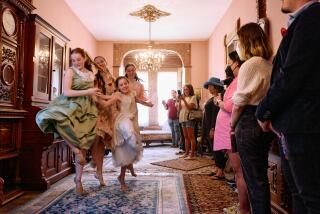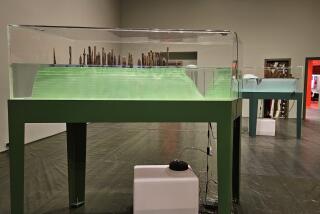One ‘Body’ Is Better Than the Other
- Share via
Tears and sneers alternate and clash in “The Transparent Body,” Joe Goode’s latest one-act essay in confessional, dance-based performance art.
Mocking his own familiar role of truth teller, performer-choreographer Goode wants to manipulate the audience shamelessly yet also boldly satirize shameless audience manipulation. He wants to wistfully invoke a time before he was (in his words) “tainted by experience,” yet parody the idea by camping it up as Heidi in a dirndl and blond pigtails.
These intentions ultimately cancel each other out because, above all, Goode wants to hog the spotlight. At the Irvine Barclay Theatre on Thursday, he used his fine six-dancer company and a charming little trestle stage designed by Jack Carpenter merely as a garnish or backdrop to what amounted to a one-man stand-up act about the conflict between truth and artifice in the theater.
In this Eclectic Orange Festival event, the sign on his microphone stand read, “Truth Spoken Here,” but Goode offered fair warning that “everything you will see and hear tonight will not be completely true....Mostly it will be flat-out lies.” Next came wildly melodramatic accounts of an abusive truck-driver father, a maimed brother and a dead lover who miraculously reappeared to Goode as an angel of forgiveness.
In previous works, stories of pain, oppression and loss served to display Goode’s bruised sensitivities. Here, however, they explained his need to escape into flamboyant theatricality and seek a career (in a phrase assigned to dancer Felipe Barrueto-Cabello) “rewriting the script of one’s life.”
But since Goode spent so much time Thursday condemning the rewrites as fabrication, it was easy to interpret “The Transparent Body” as his repudiation of autobiographical performance art.
Certainly his recent “What the Body Knows,” also on the program, expressed the same distrust of the narrator-as-seer and hearts worn publicly on sleeves. But, in this case, fine, extensive dance sequences held their own against Goode’s ironic text and the clever video projections by Douglas Rosenberg.
Goode didn’t perform in this work, but his verbal style shaped the performance of Elizabeth Burritt as the commentator who exuded unfailing empathy. “I was bred to be sympathetic....and I am a natural,” she cooed. But all her understanding soon seemed downright crazed as she exemplified what happens when people don’t listen to the body and instead get lost in illusions about themselves.
Indeed Goode portrayed her specious, ever-so-caring attitude (matched by Jennifer Wright Cook’s later on) as a way of maintaining a safe distance from the most intense experiences in life. Another example of mind-versus-body playoffs included Marit Brook-Kothlow’s fixation on the impassive Barrueto-Cabello.
If “The Transparent Body” turned out to be all talk and no action, “What the Body Knows” showed bodies at their most expressive and eloquent.
More to Read
The biggest entertainment stories
Get our big stories about Hollywood, film, television, music, arts, culture and more right in your inbox as soon as they publish.
You may occasionally receive promotional content from the Los Angeles Times.










